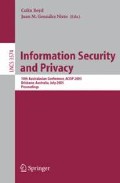Abstract
A blind signature scheme is a protocol for obtaining a digital signature from a signer, but the signer can neither learn the messages he/she sign nor the signatures the recipients obtain afterwards. Partially blind signature is a variant such that part of the message contains pre-agreed information (agreed by the signer and the signature requester) in unblinded form, while threshold blind signature distributes the signing power to a group of signers such that a signature can only be produced by interacting with a predetermined numbers of signers. In this paper, we propose a threshold partially blind signature scheme from bilinear pairings and an ID-based partially blind signature scheme, which are provably secure in the random oracle model. To the best of authors’ knowledge, we give the first discussion on these two notions.
Access this chapter
Tax calculation will be finalised at checkout
Purchases are for personal use only
Preview
Unable to display preview. Download preview PDF.
References
Abe, M., Fujisaki, E.: How to Date Blind Signatures. In: Kim, K.-c., Matsumoto, T. (eds.) ASIACRYPT 1996. LNCS, vol. 1163, pp. 244–251. Springer, Heidelberg (1996)
Abe, M., Okamoto, T.: Provably Secure Partially Blind Signatures. In: Bellare, M. (ed.) CRYPTO 2000. LNCS, vol. 1880, pp. 271–286. Springer, Heidelberg (2000)
Boldyreva, A.: Threshold Signature, Multisignature and Blind Signature Schemes Based on the Gap-Diffie-Hellman-Group Signature Scheme. In: Desmedt, Y.G. (ed.) PKC 2003. LNCS, vol. 2567, pp. 31–46. Springer, Heidelberg (2002)
Boneh, D., Lynn, B., Shacham, H.: Short Signatures from the Weil Pairing. In: Boyd, C. (ed.) ASIACRYPT 2001. LNCS, vol. 2248, pp. 514–532. Springer, Heidelberg (2001)
Chaum, D., Fiat, A., Naor, M.: Untraceable Electronic Cash. In: Goldwasser, S. (ed.) CRYPTO 1988. LNCS, vol. 403, pp. 319–327. Springer, Heidelberg (1990)
Chow, S.S.M., Hui, L.C.K., Yiu, S.M., Chow, K.P.: Forward- Secure Multisignature and Blind Signature Schemes. Applied Mathematics and Computation (2004) (accepted)
Chow, S.S.M., Hui, L.C.K., Yiu, S.M., Chow, K.P.: Two Improved Partially Blind Signature Schemes from Bilinear Pairings. Full version. Available at Cryptology ePrint Archive, 2004/108
Duc, D.N., Cheon, J.H., Kim, K.: A Forward-Secure Blind Signature Scheme based on the Strong RSA Assumption. In: Qing, S., Gollmann, D., Zhou, J. (eds.) ICICS 2003. LNCS, vol. 2836, pp. 11–21. Springer, Heidelberg (2003)
Juang, W.-S., Lei, C.-L.: A Secure and Practical Electronic Voting Scheme for Real World Environments. TIEICE: IEICE Transactions on Communications/Electronics/Information and Systems (1997)
Gennaro, R., Jarecki, S., Krawczyk, H., Rabin, T.: Robust Threshold DSS Signatures. In: Maurer, U.M. (ed.) EUROCRYPT 1996. LNCS, vol. 1070, pp. 354–371. Springer, Heidelberg (1996)
Kim, J., Kim, K., Lee, C.: An Efficient and Provably Secure Threshold Blind Signature. In: Kim, K.-c. (ed.) ICISC 2001. LNCS, vol. 2288, pp. 318–327. Springer, Heidelberg (2002)
Lenti, J., Loványi, I., Nagy, Á.: Blind Signature Based Steganographic Protocol. In: IEEE International Workshop on Intelligent Signal Processing (2001)
Liu, L., Cao, Z.: Universal Forgeability of a Forward-Secure Blind Signature Scheme Proposed by Duc et al. Cryptology ePrint Archive, 2004/262
Pedersen, T.P.: Distributed Provers with Applications to Undeniable Signatures. In: Davies, D.W. (ed.) EUROCRYPT 1991. LNCS, vol. 547, pp. 221–242. Springer, Heidelberg (1991)
Pointcheval, D., Stern, J.: Provably Secure Blind Signature Schemes. In: Kim, K.-c., Matsumoto, T. (eds.) ASIACRYPT 1996. LNCS, vol. 1163, pp. 252–265. Springer, Heidelberg (1996)
Schnorr, C.-P.: Security of Blind Discrete Log Signatures against Interactive Attacks. In: Qing, S., Okamoto, T., Zhou, J. (eds.) ICICS 2001. LNCS, vol. 2229, pp. 1–12. Springer, Heidelberg (2001)
Schnorr, C.P.: Enhancing the Security of Perfect Blind DL-Signatures (December 2003) (manuscript)
Shamir, A.: How to Share A Secret. Communications of the ACM 22(11), 612–613 (1979)
Shamir, A.: Identity-Based Cryptosystems and Signature Schemes. In: Blakely, G.R., Chaum, D. (eds.) CRYPTO 1984. LNCS, vol. 196, pp. 47–53. Springer, Heidelberg (1985)
Vo, D.L., Zhang, F., Kim, K.: A New Threshold Blind Signature Scheme from Pairings. In: Symposium on Cryptography and Information Security, SCIS 2003, vol. 1/2, pp. 233–238 (2003)
Wagner, D.: A Generalized Birthday Problem. In: Yung, M. (ed.) CRYPTO 2002. LNCS, vol. 2442, pp. 288–303. Springer, Heidelberg (2002)
Yuen, T.H., Wei, V.K.: Fast and Proven Secure Blind Identity-Based Signcryption from Pairings. In: Menezes, A. (ed.) CT-RSA 2005. LNCS, vol. 3376, pp. 305–322. Springer, Heidelberg (2005)
Zhang, F., Kim, K.: Efficient ID-Based Blind Signature and Proxy Signature from Bilinear Pairings. In: Safavi-Naini, R., Seberry, J. (eds.) ACISP 2003. LNCS, vol. 2727, pp. 312–323. Springer, Heidelberg (2003)
Zhang, F., Safavi-Naini, R., Susilo, W.: Efficient Verifiably Encrypted Signature and Partially Blind Signature from Bilinear Pairings. In: Johansson, T., Maitra, S. (eds.) INDOCRYPT 2003. LNCS, vol. 2904, pp. 191–204. Springer, Heidelberg (2003), Revised version available at http://www.uow.edu.au/~wsusilo
Author information
Authors and Affiliations
Editor information
Editors and Affiliations
Rights and permissions
Copyright information
© 2005 Springer-Verlag Berlin Heidelberg
About this paper
Cite this paper
Chow, S.S.M., Hui, L.C.K., Yiu, S.M., Chow, K.P. (2005). Two Improved Partially Blind Signature Schemes from Bilinear Pairings. In: Boyd, C., González Nieto, J.M. (eds) Information Security and Privacy. ACISP 2005. Lecture Notes in Computer Science, vol 3574. Springer, Berlin, Heidelberg. https://doi.org/10.1007/11506157_27
Download citation
DOI: https://doi.org/10.1007/11506157_27
Publisher Name: Springer, Berlin, Heidelberg
Print ISBN: 978-3-540-26547-4
Online ISBN: 978-3-540-31684-8
eBook Packages: Computer ScienceComputer Science (R0)

